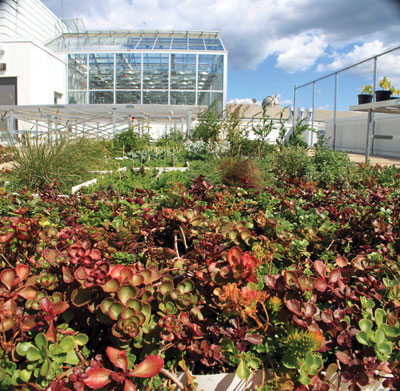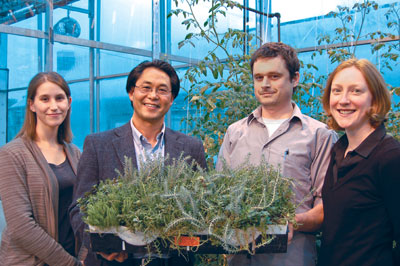
As the demand for green roofs grows, greenhouse producers could soon be
presented with a new opportunity to grow the sod-like mats that serve as
“carpets” for rooftop plant installation.
As the demand for green roofs grows, greenhouse producers could soon be presented with a new opportunity to grow the sod-like mats that serve as “carpets” for rooftop plant installation.
 |
|
| U of Guelph green roof. PHOTO COURTESY YOUBIN ZHENG Advertisement
|
Prof. Youbin Zheng, environmental horticulture chair of the University of Guelph and Vineland Research and Innovation Centre, says adapting green roof plant production for greenhouses represents a new, innovative way for the greenhouse industry to stay active during slow months, and meet green roof demand.
“Green roofs have so much to offer, from storm water management to energy conservation to increased biodiversity,” says Zheng. “However, the lack of supply for plants specifically prepared for green roof installation is limiting the extent green roofs can be adopted – that’s why getting greenhouse producers on board is important.”
Zheng is heading a team that’s developing management strategies to grow green roof vegetation – such as sedum, perennial flower plants and juniper – more quickly and effectively.
NORTH AMERICAN INTEREST GROWING IN MAJOR MARKETS
■ This research mirrors recent trends towards green roofs, which were once thought to be an exclusively European experience. For example, in the City of Toronto alone there are about 135 green roofs, with more in the works as commercial and residential building owners continue to pick up the idea.
Zheng hopes greenhouses could produce green roof plants with the team’s newly developed, soilless production system that yields plants in an impressive four to five weeks, compared to a conventional growing season of up to six months.
The key to this development is a lightweight-vegetative mat. Plants can be grown hydroponically outside and indoors, and on soil or concrete. Through hydroponics, producers can control exactly how many nutrients the plants receive and how much oxygen is in the water.
Zheng says that greenhouses already have the infrastructure needed to make this production system a success and the team predicts that the mat will be very cost effective to produce and install.
WHAT ARE THE BEST PLANT COMBINATIONS?
■ The vegetative mat can support any plant species, but the research team is working to find the best plant combinations, so that they can create green roofs that are resilient and energy efficient for northern climates.
For example, they found planting Lamiastrum galeobdolon ‘Herman’s Pride’ and Sedum album ‘Coral Carpet’ together resulted in a successful plant species combination for partial shade conditions.
Zheng adds that the system’s soilless properties open up doors to other markets.
“The soilless technology eliminates border barriers that would otherwise restrict the trade of soil and plants internationally,” he says. “This means producers can potentially supply markets in the United States and Europe with competitively priced, high-quality green roof vegetation.”
Indeed, after growing the plants, producers can preserve them in cold storage for up to four weeks and then ship them around the world.
GREEN ROOFS GREAT IN STORM WATER CONTROL
■ This bodes well for the sector as green roofs’ advantages, such as storm water management, continue to emerge. The vegetation layer works well to absorb rainfall, delaying entry into sewer systems.
 |
|
| Research technician Katherine Vinson, Prof. Youbin Zheng, masters student Greg Yurist, and research associate Mary Jane Clark. PHOTO by SAMANTHA BEATTIE |
As well, green roofs increase solar panel efficiency by reducing the amount of airborne pollutants and dust commonly found on bare roofs. This lowers solar panel maintenance costs and improves performance.
By providing insulation in the winter and warding off heat in the summer, green roofs better regulate rooftop and solar panel temperatures – guaranteeing more reliable power generation.
But that’s not all. In a study conducted by the City of Toronto, researchers found that for a one-storey, warehouse type building, energy savings can be up to 50 to 70 per cent. This is part of the reason, in 2008, Toronto was the first city in North America to pass a bylaw that requires residential, commercial and institutional developments to have a minimum floor area of 2,000 metres-squared and at least six storeys in height before installing a green roof.
DETERMINING THE OPTIMAL MAT PRODUCTION SYSTEMS
■ Moving forward, Zheng and his team are continuing to search for the best production and maintenance practices. Along with the vegetative mat production system, they’ve also found optimal substrate pH levels and fertilizer rates, which can speed up growing periods, improve maintenance efficiency and costs, and boost green roof longevity and health. Zheng says these substrate recipes will soon be available for companies to license and put into production.
“We are applying our horticulture knowledge to improve green roof production, installation and maintenance with as little environmental pollution and stressors as possible,” says Zheng. “And we want to share this knowledge with green roof companies, architects, producers and students in a multidisciplinary collaboration.”
Others involved include Prof. Mike Dixon, graduate student Greg Yuristy, horticulturalists Mary Jane Clark, Katherine Vinson and Linping Wang, plant pathologist Lynn Tian, undergraduate students Siobhan Dunets, Thannushan Nimalendra and Mohammad Eftekha, as well as co-op student Arline Otta.
This project receives funding from the Ontario Ministry of Agriculture, Food and Rural Affairs through the OMAFRA/UofG program, Carrot Common, Life Roof Ontario, Sedum Master and Landscape Ontario.
Samantha Beattie is a writer in the SPARK (Students Promoting Awareness of Research Knowledge) program at the University of Guelph.
Print this page